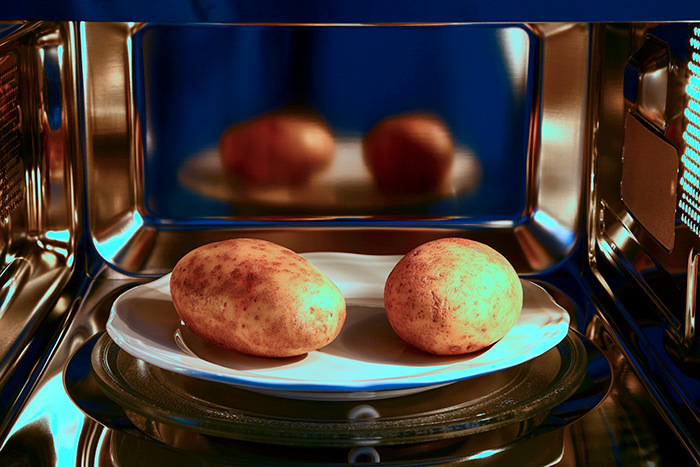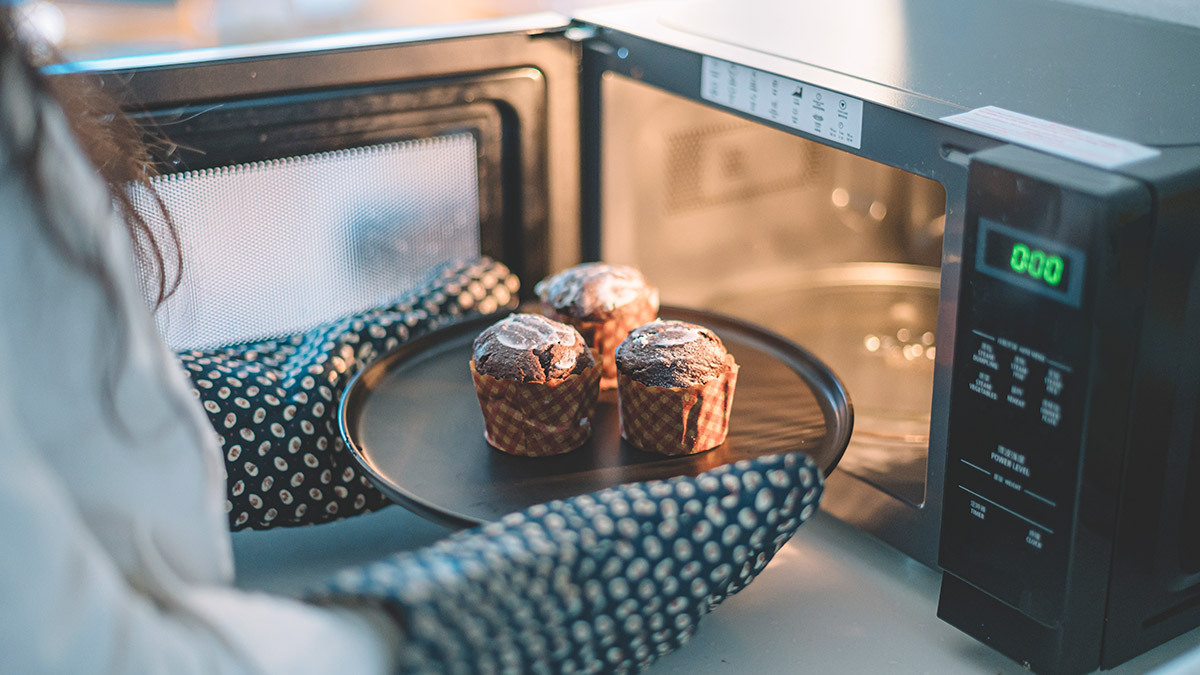Need to know
- Convection microwaves, or combination ovens, combine the functionality of a microwave with the ability to brown and crisp food like a standard oven
- Their compact size means they preheat faster than a standard oven, and are ideal for cooking and reheating small quantities of food. But many models can only reach a maximum temperature of 200°C
- The latest CHOICE expert review of convection microwaves includes 28 models priced from $169 to over $2000
What do you get when you combine a regular microwave with a benchtop oven?
Convection microwaves allow you to steam, reheat and cook food just like you do in a microwave, but rather than just using electromagnetic heat to cook food in the way a traditional microwave does, they have an additional oven-style heating element and fan to circulate heat around the cavity. This means you can also use them for baking, browning and crisping – functions you'd usually need an oven or grill for.
All this in a unit that's smaller than an oven and can sit on your benchtop. But are convection microwaves worth buying?
On this page:
- What are convection microwaves good for?
- Can a convection microwave replace an oven?
- How much space do I need for a convection microwave?
- What foods can you cook in a convection oven?
- Convection microwaves vs air fryers
- Cleaning a convection microwave
What are convection microwaves good for?
CHOICE kitchen appliance expert and home economist, Fiona Mair, says convection micorwaves are useful and versatile, with many attributes that make them a valid rival to other popular benchtop appliances such as air fryers.
"A convection microwave has an element and a fan, as well as a top element for grilling. Because of this, it can be used as a microwave, an oven, or a grill. You can also use it in combination mode, which combines the microwave with either the bake or grill functions to reduce the cooking time," she says.
It can be used as a microwave, an oven, or a grill
Fiona Mair, CHOICE kitchen expert
Because they are smaller than conventional ovens, convection microwave ovens are ideal for smaller spaces, such as kitchenettes, caravans, campervans, holiday homes and granny flats.
They would also suit people living on their own who are cooking smaller quantities of food, or they can be useful for a large family that needs extra oven space.
And good news if you always have hungry kids prowling around the house: "They're also great for teenagers who like a hot afternoon snack, as they're easy to operate and heat up more quickly than conventional ovens," suggests Fiona.
It's worth noting, however, that convection microwaves don't do well at cooking delicate foods such as custards or souffles, which can rise too fast or become dried out due to the speed of cooking.
Can a convection microwave replace an oven?
Yes and no.
If you're cooking large volumes, such as a Sunday roast with multiple trays of meat and veggies, you'll still need to use a regular oven, as most convection microwaves only have one shelf, and limited space.
But if you're cooking smaller quantities on a single tray, you can combine cooking functions such as convection and grill for browning meat and roasting vegetables.
What if you're cooking pizza or pastry from scratch?
"Because it doesn't have a base element," explains Fiona, "results are not great for browning and crisping pastries and pizzas on the bottom".
Some models come with a crisp plate, which is designed to heat food from below, but your food is restricted to the size of the crisp plate.
Convection microwave ovens are ideal for smaller spaces, such as kitchenettes, caravans, campervans, holiday homes and granny flats
The upside is that they are great for reheating pre-cooked pastries and pizzas, as they can reach a high temperature in a short time – but many only have a maximum temperature of 200°C.
This quick preheat means they are also cheaper to run than standard ovens, so they can offer considerable savings on energy costs. You can also combine functions – such as roast or grill – with the microwave function, to speed up the cooking time.
How much space do I need for a convection microwave?
If you're considering buying a convection microwave, you'll also need to consider if you have space for it.
A convection microwave requires more ventilation around the unit than a standard microwave, so you'll need to weigh up how much space you have on the bench or in a cavity.
"They are usually larger units with a protrusion at the back of the unit," says Fiona.

Convection microwaves can be suitable for roasting small cuts of meat, or small quantities of vegetables.
What foods can you cook in a convection oven?
There are specific dishes that work well in a convection microwave oven. They're good for reheating because of their ability to preheat quickly and make food crispy. While they're not ideal for cooking fresh pizzas and pies from scratch (because they don't have a base element), you can use them to heat up frozen or leftover pizza and pastry.
Because of the grill function, they're great for melting cheese toasties and browning the top of gratins and pasta bakes. They're also suitable for roasting small cuts of meat or small quantities of vegetables.
"I like to toast nuts and make vegetable chips in my convection microwave, too," adds Fiona.
Other pre-programmed settings include steaming and slow-cooking.
Fiona says she has seen the design of these appliances evolve to offer multi-shelf cooking for baking batches of biscuits or cakes, accessories such as crisp plates to help cook food from the bottom, and features such as soft-close doors and reduced operating noise.
Convection microwaves vs air fryers
There is (still) a lot of hype around air fryers, but Fiona says a convection microwave may be a better buy.
"If you choose a convection microwave over an air fryer, you will have a microwave, a grill and an oven all in one, so it's more versatile," she says.
The main difference between a benchtop-oven-style airfryer and a convection microwave is that the air fryer has the element and fan positioned on the top and the convection microwave fan and element is positioned on the back wall.
Convection microwaves can cook similar foods to air fryers, but they have a slightly larger capacity than many standard air fryers so you can cook more food in one go.
"They do take up a bit more bench space and running costs may be slightly higher than with an air fryer, but why have more appliances in your kitchen than you need?" says Fiona.
If you choose a convection microwave over an air fryer, you will have a microwave, a grill and an oven all in one
CHOICE kitchen expert, Fiona Mair
Although convection microwaves can be slightly more expensive to buy than air fryers, there are options to suit different budgets. You can pick up an air fryer for under $100 but the top-of-the-range models cost around $600. The cheapest convection microwave we've tested is a Kmart model for $169 but other brands can cost over $1000 or more.
As with many appliances we review, in our convection microwave reviews, we found that spending more doesn't necessarily always get you the best performing product, so be sure to check our reviews before you buy.
Can you air fry in a convection microwave?
If you're really torn between a convection microwave and an air fryer, why not have both in one appliance? Some convection microwave models now double as air fryers, featuring an air fryer mode that can be used to brown and reheat frozen foods. An example is the Breville the Combi Wave, which is an air fryer, convection oven and microwave in one.
Many of these appliances will also come with airfryer-style accessories such as racks or an air fryer basket, which you'll need to use in order get the most out of this function.
Keep in mind if you're buying a convection microwave with an air fryer mode that it may only have a selection of auto programs you can use with that mode.
Cleaning a convection microwave
Before you buy, be aware that cleaning can be an issue with convection microwaves. It's important to clean the cavity after each use, as splatters can occur and the residue can then be 'baked on' when using convection mode if they're not wiped out properly.
You'll also need to ensure the fan is frequently cleaned to ensure proper airflow – a dirty fan can mean poor cooking results in convection mode.
CHOICE experts have reviewed a variety of both traditional microwaves and convection microwaves to help you find the option that's right for you and your budget. CHOICE members have exclusive access to our detailed reviews of products and services across over 200 categories.
What do CHOICE Community members say?
While a couple of CHOICE Community members are not won over by their convection microwave ovens, many are quick to sing their praises.
One CHOICE Community Member says: "I am on my third combined convection/microwave oven, over many years. They have varied from an expensive Sharp model to a cheap Kmart model. Whilst it does not replace my standard oven, it is great for cooking small quantities, eg crisping up frozen bread rolls, melting cheese on toast or cooking a small casserole. The convection/microwave combination is also great for sponge cakes – cooking in less time, giving a light and airy sponge and also browning. It heats up quicker than my large oven and uses less electricity."
Another member says the versatility is a plus: "I have a Sharp convection microwave. It gets used mostly as a plain microwave but I like that I can use it as a small oven which doesn't heat up the kitchen as much as the regular oven. I use it a lot for baking cakes and making cheese on toast. It also has a setting for cooking pizza which works really well."
Stock images: Getty, unless otherwise stated.



